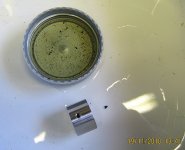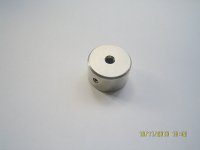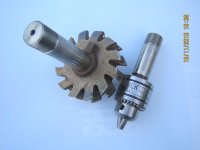Hi
I'm making a replacement rider weight for a friend's SME 3009 arm. I had a roundbar of very hard non-magnetic stainless steel and just about finished the job when I drilled a hole for an M3 thread in the side to take a stainless grubscrew.
I tapped the thread with a very good quality set of 3 taps and the no 1 and 2 taps worked fine, using 3 different types of tapping lubricant as the material is very hard.
So, when I came to tapping with the 3rd tap, it broke off just above the hole with almost nothing to grip. I tried a small chuck, a pin chuck but the remains of the tap is too brittle.
I have some sulphuric acid, phosphoric acid and some nitric acid and decided to place the workpiece into the nitric.
After about an hour's immersion, I am noticing some bubbles and a bit of black sediment but the stainless workpiece seems unaffected by the acid.
How long do you think it will take to dissolve the piece of broken tap?
I read another thread about the same situation where someone suggested to heat the nitric.
The job is now in a small plastic container. If heating the acid will speed things up, what kind of container should I use for the nitric?
bulgin
I'm making a replacement rider weight for a friend's SME 3009 arm. I had a roundbar of very hard non-magnetic stainless steel and just about finished the job when I drilled a hole for an M3 thread in the side to take a stainless grubscrew.
I tapped the thread with a very good quality set of 3 taps and the no 1 and 2 taps worked fine, using 3 different types of tapping lubricant as the material is very hard.
So, when I came to tapping with the 3rd tap, it broke off just above the hole with almost nothing to grip. I tried a small chuck, a pin chuck but the remains of the tap is too brittle.
I have some sulphuric acid, phosphoric acid and some nitric acid and decided to place the workpiece into the nitric.
After about an hour's immersion, I am noticing some bubbles and a bit of black sediment but the stainless workpiece seems unaffected by the acid.
How long do you think it will take to dissolve the piece of broken tap?
I read another thread about the same situation where someone suggested to heat the nitric.
The job is now in a small plastic container. If heating the acid will speed things up, what kind of container should I use for the nitric?
bulgin
Hello broken tap
You can get a centre punch and chip the broken tap out, some times the centre punch is not as tough a material as the tap but I have used a concrete nail and that works also. The threads will be damaged just a bit, then get a drill that is about .003" or .076mm bigger then the tap drill size and redrill the hole, make sure to drill the hole deeper to make up for the fact that there will be less thread for the screw to hold on to. I think you are using a series 400 stainless. Very tough stuff!
GOOD LUCK!!
You can get a centre punch and chip the broken tap out, some times the centre punch is not as tough a material as the tap but I have used a concrete nail and that works also. The threads will be damaged just a bit, then get a drill that is about .003" or .076mm bigger then the tap drill size and redrill the hole, make sure to drill the hole deeper to make up for the fact that there will be less thread for the screw to hold on to. I think you are using a series 400 stainless. Very tough stuff!
GOOD LUCK!!
For something like that it's usually easier to just make a new one. If you have to save it, I'd try to find a shop that has a plunge EDM machine. They can burn it out in short order with no damage to the part. I don't know if you'll ever be successful with acids and the like, plus nitric is awfully dangerous stuff at a strength that has a chance of working. If it was hard going in, there's little chance of twisting it out. You can maybe break it up if there isn't much depth, but that's also pretty hard to do.
In the future, in material that tough, use a larger drill size and go for a lower thread percentage. It will still be plenty strong but will tap easily and save taps.
Conrad
In the future, in material that tough, use a larger drill size and go for a lower thread percentage. It will still be plenty strong but will tap easily and save taps.
Conrad
Hi Guys
Thanks for your advices. My centre punches are too big for the 3mm hole but I do have drifts which may crack the broken tap piece which is at most only 5mm long.
As I write, the workpiece is still in the nitric but I haven't looked at the situation since last night.
Last evening, I observed the acid's action periodically for a few hours and there was quite a bit of activity with bubbles and blackish sediment coming out of the thread hole which is open at both ends as I drilled the weight's centrehole before the tap snapped.
The nitric acid I have here btw, is used to desmut aluminium prior to anodising but I'm not sure of its strength.
A few weeks ago, I had my first .3mm drillbit broke in years, drilling into aluminium. As I was curious to find out for myself if the acid method works, I placed the tiny alu cylinder with the broken bit stuck inside in a few ml of nitric acid, and then promptly forgot about my wannabe experiment.
I remembered about it last night (after about 2 to three weeks) and found no trace of the drillbit in the acid and even the aluminium workpiece was about 80% dissolved.
@ Conrad
Thanks for your opinion too. Some months ago I had a fascinating peek at your shop facilities. Perhaps you are right, it may well be easier and quicker to re-do the job. I still have about 12" of this very hard stainless roundbar but its dia is just too thick to go right through the headstock chuck on my Myford lathe so I had to cut off enough for the job using a hacksaw.
After turning the job, I wanted to use a parting tool but decided against this as I heard some ominous creaking of the tool on the workpiece, even with lubricant - so I had to do the hacksaw thing again. This should give an idea of the hardness of the steel I'm working with for this job.
I'll post here later as to what happened with the nitric method.
Regards
bulgin
Thanks for your advices. My centre punches are too big for the 3mm hole but I do have drifts which may crack the broken tap piece which is at most only 5mm long.
As I write, the workpiece is still in the nitric but I haven't looked at the situation since last night.
Last evening, I observed the acid's action periodically for a few hours and there was quite a bit of activity with bubbles and blackish sediment coming out of the thread hole which is open at both ends as I drilled the weight's centrehole before the tap snapped.
The nitric acid I have here btw, is used to desmut aluminium prior to anodising but I'm not sure of its strength.
A few weeks ago, I had my first .3mm drillbit broke in years, drilling into aluminium. As I was curious to find out for myself if the acid method works, I placed the tiny alu cylinder with the broken bit stuck inside in a few ml of nitric acid, and then promptly forgot about my wannabe experiment.
I remembered about it last night (after about 2 to three weeks) and found no trace of the drillbit in the acid and even the aluminium workpiece was about 80% dissolved.
@ Conrad
Thanks for your opinion too. Some months ago I had a fascinating peek at your shop facilities. Perhaps you are right, it may well be easier and quicker to re-do the job. I still have about 12" of this very hard stainless roundbar but its dia is just too thick to go right through the headstock chuck on my Myford lathe so I had to cut off enough for the job using a hacksaw.
After turning the job, I wanted to use a parting tool but decided against this as I heard some ominous creaking of the tool on the workpiece, even with lubricant - so I had to do the hacksaw thing again. This should give an idea of the hardness of the steel I'm working with for this job.
I'll post here later as to what happened with the nitric method.
Regards
bulgin
OK, Gents
The broken tap saga has a happy ending. The nitric acid dissolved 5mm of a #3 3mm tap in 12 hours on the dot and the pesky no charge little job for a friend has been saved.
The larger particle to the right of the workpiece is all that remained and just fell out of the workpiece when I removed it from the acid.
And I think there's enough left of the expensive #3 tap to regrind and use it again😀
Thanks for your kind attention to my question.
Regards
bulgin
The broken tap saga has a happy ending. The nitric acid dissolved 5mm of a #3 3mm tap in 12 hours on the dot and the pesky no charge little job for a friend has been saved.
The larger particle to the right of the workpiece is all that remained and just fell out of the workpiece when I removed it from the acid.
And I think there's enough left of the expensive #3 tap to regrind and use it again😀
Thanks for your kind attention to my question.
Regards
bulgin
Attachments
Cool! 😀
I have some arthritis just about everywhere, and the thought of hacksawing through a bar of hard stainless (twice!) makes me hurt just thinking about it. My lathe spindle is also very small so I'm familiar with the problem. They have a power hacksaw at work so if something is too big to do by hand, I saw it off there, but I don't know how it would like hard stainless. My preferred cutting oil is Cool Tool II for most things, but something like that is why one should keep a pint of Castrol Moly-Dee on hand, especially for parting off.
Best,
Conrad
I have some arthritis just about everywhere, and the thought of hacksawing through a bar of hard stainless (twice!) makes me hurt just thinking about it. My lathe spindle is also very small so I'm familiar with the problem. They have a power hacksaw at work so if something is too big to do by hand, I saw it off there, but I don't know how it would like hard stainless. My preferred cutting oil is Cool Tool II for most things, but something like that is why one should keep a pint of Castrol Moly-Dee on hand, especially for parting off.
Best,
Conrad
ominous creaking of the tool on the workpiece,
That ominous creaking of the tool on the workpiece, may mean a dull tap. If tools are not sharp it will bind and brake. There are tools out there made for stainless that have a cutting angle made to cut stainless. Stainless work hardends when cutting it. Glad it worked out using the acid😉
Peter C.
That ominous creaking of the tool on the workpiece, may mean a dull tap. If tools are not sharp it will bind and brake. There are tools out there made for stainless that have a cutting angle made to cut stainless. Stainless work hardends when cutting it. Glad it worked out using the acid😉
Peter C.
Hi Guys
The little job's done😀 Thanks again for your kind advices🙂
All my cutters are razorsharp as I'm an old needlemaker so all my cutters just have to be sharp. I have 3 3x3pcs tapsets and all of them are almost new as I usually work with smaller sizes.
As I worked with this hard steel, I remembered why I bought it - I made two tools for my mill with it - two threaded 16mm spindles to fit a 16mm collet for my mill chuck. The one spindle spins an Eclipse chuck for precision drilling on my mill and the other spins a rather massive profile cutter.
@ Conrad
I do have easy access to my engineering society's electric saw but there was no time to go there.
Incase anyone's interested in my handy chuck spindle for my mill, I'll post a pic in a mo'.
Cheers
bulgin
The little job's done😀 Thanks again for your kind advices🙂
All my cutters are razorsharp as I'm an old needlemaker so all my cutters just have to be sharp. I have 3 3x3pcs tapsets and all of them are almost new as I usually work with smaller sizes.
As I worked with this hard steel, I remembered why I bought it - I made two tools for my mill with it - two threaded 16mm spindles to fit a 16mm collet for my mill chuck. The one spindle spins an Eclipse chuck for precision drilling on my mill and the other spins a rather massive profile cutter.
@ Conrad
I do have easy access to my engineering society's electric saw but there was no time to go there.
Incase anyone's interested in my handy chuck spindle for my mill, I'll post a pic in a mo'.
Cheers
bulgin
Attachments
Last edited:
- Status
- Not open for further replies.
- Home
- General Interest
- Everything Else
- Broken-off M3 tap in very hard stainless roundbar


